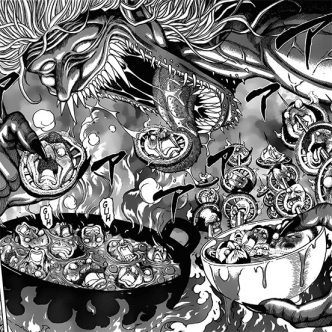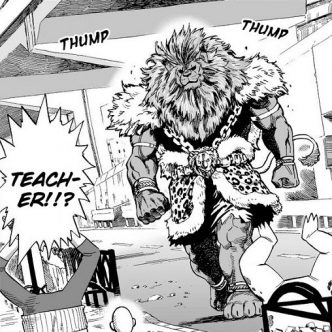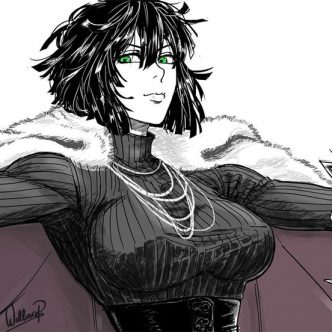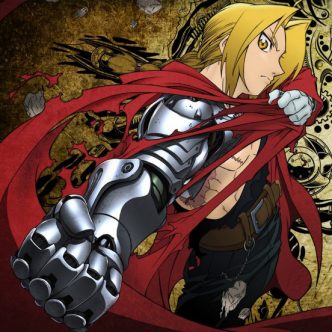Manga vs Anime
If you’re reading this article, I think you don’t need any introductions and definitions of manga and anime. It’s more interesting to compare how popular these two kinds of art in the whole world. The only exception is Japan, of course, where people of all ages read manga and respect it as a form of visual art and a literary phenomenon. Manga amounts one fourth of all the reading material in Japan. According to experts, about 95% of Japanese people read manga on a regular basis. Obviously, the industry returns good interest. For instance, in 2011, they sold over 503,610,000 volumes of manga that brought in an income of 272 billion yens, which is 3,5 billion dollars. Not bad, isn’t it?
Popular works, more often long manga series, are usually adapted into anime. In commercial terms, making anime based on manga that is already in favor is reasonable since drawing manga is not so expensive and animation studios can see whether a manga is popular or not and decide whether they’re going to make its screen version. It means that in Japan manga has the advantage of anime in that a few producers are ready to invest in a project that hasn’t been in great demand and hasn’t paid for itself as a comic. Viewers in Japan are a major part of the population regardless of the age, sex, education and social class.
As for the rest of the world, the situation changes dramatically and it’s anime that is placed in the forefront. Of course, manga is in favor as well (for example, in 2006, the sales were 175 million dollars in the US) but anime is incomparably more popular and readers usually buy manga based on popular anime. How come? There are some reasons, objective and subjective, so let’s try to figure out why some people prefer anime and others choose manga.
I should warn you that this review is NOT about what is better: manga or anime. I’m just going to share my own experience and conclusions. First, I’m going to cover the advantages of anime comparing to manga as its (manga’s) disadvantages can be viewed as positive aspects of anime.
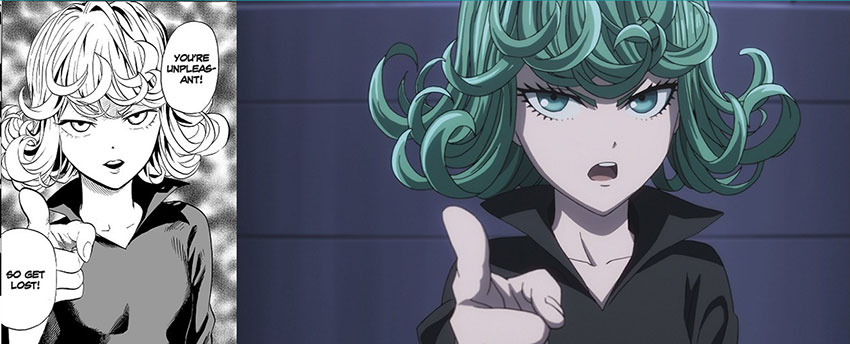
Tatsumaki in Manga and Anime (One Punch Man character)
Anime: pro arguments
1. Popularity
Anime is more widespread around the world than manga although lots of its fans don’t even know such terms. An anime is an animated cartoon and cartoons are usually very popular. We can see them on TV, in cinemas and DVDs. By and large, an ordinary TV viewer doesn’t see the difference between anime and animated series form other countries and knows nothing about mangas this or that series are based on. According to statistics, about 60% of all the animated TV series in the world is anime. Thus anyone can just turn on the TV and see anime any time.
As for manga, the situation is more difficult since there are fewer manga publishers in other countries than in Japan. It’s a hard task to find, for example, Berserk tankobons but you can easily buy DVDs with Berserk series. With translated-unprofessionally versions being spread, manga has become more available but still for those who is searching purposefully.

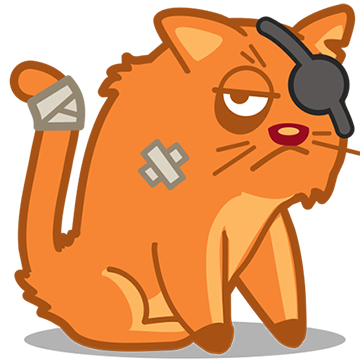
2. Action
A manga is a comic strip that combines the elements of such arts as literature and visual arts. Roughly said, it’s a book with pictures and besides it’s usually black-and-white. Regardless of a mangaka’s ability to convey the dynamics of movements and fights in a static image (and some artists aren’t endowed with such a skill), it won’t be as good as animation just because it lacks necessary instruments. Besides movements and colors, anime creators also use sound. Soundtrack and characters’ voices play a big part in perception of a piece on the whole.
Some people just don’t possess great imagination that could help them put manga pictures in motion in their minds. Contrary, a good anime will show you a whole new world full of festive colors, sounds, and emotions! Personally, I know quite a lot of people who prefer anime to manga just for this reason. After all, some people just don’t like reading.
3. Interactivity
Different fragments from anime are usually used to create homemade AMV that we can see on Youtube and other video hostings. Very often, they are real masterpieces that are destined to be watched again and again! Anime fans also create TOPs (for example, TOP 10 fights, characters, etc.), many articles, reviews, and videos. Thus, anime is largely involved into the Internet environment and its popularity is growing rapidly.


4. Imprinting
In the Internet environment, “imprinting” is a phenomenon called “baby duck syndrome”, “from the tendency of young ducks or other birds to imprint on the first thing they see. The tendency of computer users to always think the system (software or usage paradigm) they originally started using is better” (the definitions are taken from Wiktionary). In such a way, if you have been watching anime from day one, manga will be something strange for you and different from the thing you’ve become attached to.
5. Smoothing
Here I mean the smoothing in anime of such features of original pieces as specific, poor or just slipshod artwork. I hate to say it but some mangas that are popular and really great contain such features. It’s quite subjective but in my view, such splendid works as Hunter × Hunter, One Piece, Baki the Grappler, and many others are better taken as anime series. Once you’ve grown fond of a series, its world and characters, you can move on to manga feeling that you will be able to turn a blind eye to some shortcomings in mangakas’ artwork and pay attention to their unique styles.
As for me, I’m a fan of One Piece. At first, I decided to watch the anime version since the artwork in the manga had scared me away. There is no talk about such peculiar things as Mob Psycho 100 – ONE’s art just shocks many people. However, the anime version is quite modern and attractive.


6. Attention to detail
In manga, it’s usually hard to pay attention to each detail that can be interesting for readers. For instance, an author doesn’t depict a fight to the full extent or hardly develops minor characters’ abilities and personalities. In general, it has no effect on a main storyline but just can be disappointing. In anime, such shortcomings are usually fixed. However, this one is a controversial point as many fans are opposed to such changes of an original because they think that an author’s message is distorted.
Another important thing is that it’s easier to understand what’s happening in anime than in manga, especially if the artwork is poor.
7. Alternative storyline
From time to time, animators face a problem: what to do if they’ve showed the last episode based on the last chapter at the moment and the next chapter isn’t ready yet? They can freeze the release broadcasting season by season as the new chapters come out, for example, as they did with The World God Only Knows. Sometimes, animators churn out episodes that are not connected with the main storyline and are not based on the original manga. Such episodes help to “buy time” for a mangaka to create new chapters. Naruto is a good example of that.
It’s not rear when animators develop their own original storyline upon their own initiative. For example, the creators of Fullmetal Alchemist and Hellsing developed their own variants of the stories and I think they are good and don’t yield to the original mangas’ plot lines. However, such solutions could fail. For instance, wonderful anime Soul Eater has a poorly-made ending.


8. Original version
When a manga is published, it is often made into an anime series. There are the canonical versions of Fullmetal Alchemist, Hellsing, Sailor Moon, and other mangas with minimal changes of the originals. In my view, Hellsing Ultimate is a perfect, really spectacular anime version which embodies Kouta Hirano’s conception with great accuracy.
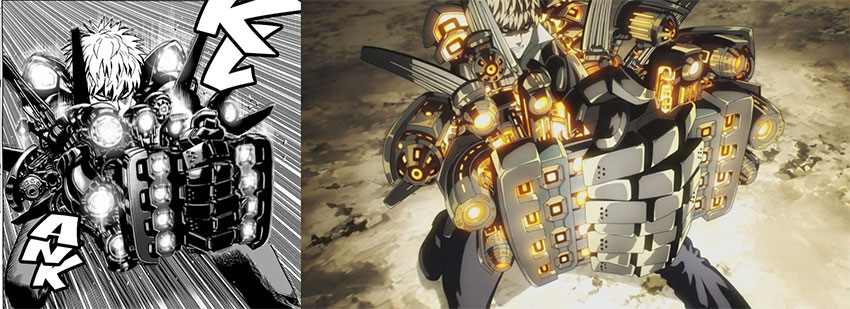
Genos in Manga and Anime (One Punch Man character)
Looking at all the advantages, we can see why anime is so popular in the world. Now let’s talk about positive aspects of manga.
Manga: pro arguments
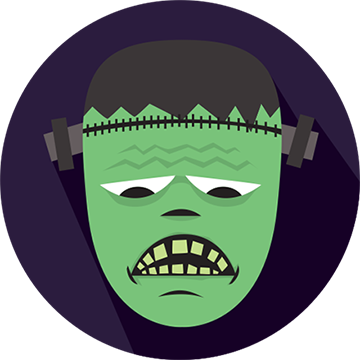
1. Fillers
Fillers are episodes that are not related to a main plot line and are added in order to prolong the duration time of a show. In most of the cases, fillers are weaker than main episodes and have no influence on the development of a story. They are often used in long anime series. For example, 255 episodes in Naruto are wholly or partially fillers and the series is still on. 255 – just think about it!
Animators can create fillers over a period of several months at a stretch forming whole arcs with their own story lines. Sometimes, they make fillers if an original manga series isn’t ready yet. However, they are more often used with the aim of making a profit.
Fillers are not something evil though. In my opinion, such episodes in One Piece are pleasing to watch and they naturally complement the whole narration. More than that, a lot of fans consider Bleach’s arc “Zanpakuto Rebellion” to be practically the best and definitely the one worthy of attention. Even in Naruto’s fillers, there were a lot of interesting characters and spectacular fights. Nevertheless, enough is enough. One Piece contains 85 fillers but Naruto – three times more! This is an outrageous attitude towards viewers. Thus lots of people prefer manga to unceasing fillers. In addition, manga readers are able to learn what’s happening in the next chapters before the anime series is ready.
2. The author’s message
Any way you slice it, a screen version of manga distorts the author’s message of an original work to a greater or lesser degree. Anime series often contain inaccuracies, mistakes and even huge changes of the mangaka’s original message for no reason at all.
Once again, I’ll give Naruto as an example where Pain, while fighting with Naruto, showed the abilities and the level of power that he had never possessed. As for me, I gave up on that anime. Another example is Ah! My Goddess where the creators just didn’t mention the 10-dimensional nature of the universe. As a result, the characters’ power went down considerably.
Read manga if you want to know all the ideas an author wanted to get over to readers, without missing any details.


3. Arguments
There are numerous forums, websites and even special wikipedias that cover the abilities and techniques of different characters as well as fights between them. The visitors of such sources frequently know original works back to front as they’ve read them a lot of times, so they’ll ridicule every opponent who’ll make reference to any anime in an effort to put forward any arguments. If you want to be able to compete in discussions and if you expect other people to take your opinion and arguments into account, you’ll have to read manga, no other way. Besides, it’s easier to show a picture from an online manga source as a proof than to offer to watch some second of some episode of such and such anime season.
4. Elitist image
This aspect is based on a simple wish of a lot of people to feel their superiority over the others. Since an ordinary otaku doesn’t have any outstanding achievements, the only reason to feel their superiority over the others is a huge store of information they possess which is really nothing remarkable. Interestingly, it concerns not only manga and anime, it’s a widespread phenomenon. Those who have read light novels or played visual novels show their superiority over anime and manga fans. Comics fans mock at those who love watching films based on comics and don’t know anything about original works.


5. Time
Reading manga saves a lot of time if you are a busy man or just don’t want to spend a lot of time on one and the same piece. On average, there are 18-20 pages in one chapter, so you can read over 50 chapters in a day. Obviously, watching 50 episodes of anime will be more time-consuming and physically harder.
Conclusion
As we can see, there are reasons for great popularity of anime as an entertainment genre. Talking about manga, for people who take interest in such kind of literature (outside of Japan, of course) their hobby is more serious. In other words, people from all over the world watch famous anime series like Oscar-winning Spirited Away by Hayao Miyazaki with great pleasure but they don’t differentiate them from Disney’s productions or of any other companies popular in the world. As a form of art, manga is very different from animation and comics that are popular in the world and manga readers know all the differences from A to Z. That way, anime is more intended for the general public not interested in Japanese modern culture and manga fans are similar to otaku as their outlook concerning Japanese culture is much wider.
Which do you prefer: manga or anime? What do you think of popularity of these two kinds of art? Share your thoughts in the comment section below.

